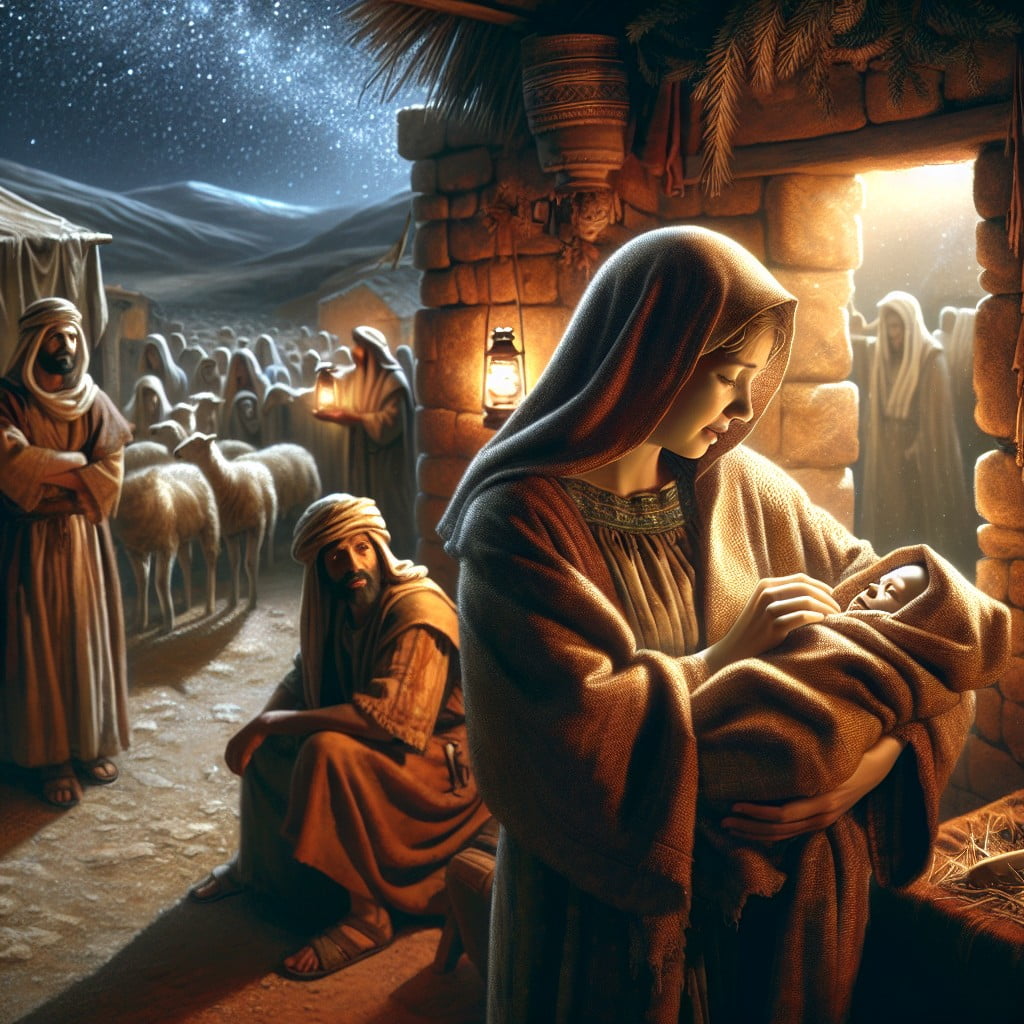Explore this fascinating journey through religious history because it uncovers the intriguing age difference between two monumental figures: John the Baptist and Jesus.
Key takeaways:
- Zechariah and Elizabeth were the parents of John the Baptist.
- Luke 1:36 indicates that John was approximately six months older than Jesus.
- John the Baptist and Jesus were born during the reign of King Herod the Great.
- John’s role was to prepare the way for Jesus by calling people to repentance.
- John’s ministry overlapped with Jesus’ ministry, emphasizing their interconnected destinies.
The Birth of John the Baptist

According to the Gospel of Luke, John’s birth was foretold by the angel Gabriel to Zechariah, John’s father. This announcement came during Zechariah’s service in the temple in Jerusalem, where he was informed that his wife Elizabeth would bear a son to be named John.
Elizabeth, a relative of Mary, the mother of Jesus, was considered beyond childbearing years, making John’s conception miraculous in nature.
Key points:
- Zechariah, a priest, and his wife Elizabeth were the parents of John the Baptist.
- The angel Gabriel announced John’s forthcoming birth to Zechariah.
- Elizabeth conceived John in her later years, signifying a miraculous event.
- Luke 1:36 states that Elizabeth was in her sixth month of pregnancy when Mary conceived Jesus, providing a clear timeline for their age difference.
Historical Context: The Time of John and Jesus’s Births

The births of John the Baptist and Jesus occurred during the reign of King Herod the Great in Judea, a time characterized by profound political and social unrest. This historical backdrop is pivotal in understanding the chronology of their lives and their interconnected missions.
Understanding the religious and social landscape of Judea under Roman rule is essential; it was a period marked by messianic expectations and spiritual yearning, which shaped the public’s reception to John’s and Jesus’s teachings.
According to historical records and the dating of Herod’s reign, John the Baptist’s birth likely took place between 6 and 4 B.C., with Jesus’s birth following shortly thereafter, typically dated around 4 B.C. or slightly later.
Feasts, fasts, and other cultural practices of the time, as described in scriptural accounts, offer indispensable clues for historians trying to pinpoint these events on the historical timeline.
The precise dating of various events, like Herod’s death, provides a framework to estimate John’s and Jesus’s ages relative to such milestones, giving us insights into the age difference between the two figures.
Scriptural References to John the Baptist’s Age
The Gospel of Luke provides the most insight into the chronological relationship between John the Baptist and Jesus. Elizabeth, John’s mother, was in the sixth month of her pregnancy when the angel Gabriel announced to Mary that she would conceive Jesus (Luke 1:26, 36). This interval suggests that John was approximately six months older than Jesus.
An analysis of Zechariah’s priestly service according to the Jewish temple’s rotation schedule can give clues to John’s exact birth date. Cross-referencing historical records of these priestly courses with the biblical account indicates John was likely born in late spring or early summer.
At the beginning of his ministry, Jesus was around thirty years old (Luke 3:23), which could imply John had started his own ministry slightly earlier, consistent with his six-month age advantage. The respective ministries of John and Jesus overlapped, further engraining the significance of their ages and roles in the biblical narrative.
Comparative Analysis of John and Jesus’s Birth Narratives
Diving into the birth narratives of John the Baptist and Jesus, a side-by-side examination unveils key events that can help deduce their age difference. Here are the salient points found in the Gospels:
- In the Gospel of Luke, angelic announcements herald the impending births of both John and Jesus. Zechariah learns of John’s conception during his service in the Jewish Temple.
- Within the same Gospel, Elizabeth, the mother of John, is in her sixth month of pregnancy when Mary conceives Jesus through divine intervention.
- Mary’s visit to Elizabeth further cements the timeline — upon Mary’s arrival, the unborn John reacts in Elizabeth’s womb, an event that underscores the six-month gestational gap.
- These narratives reinforce the understanding that John was around six months older than Jesus, assisting in the estimation of their age difference as gleaned from biblical accounts.
This sequential look at their births creates a framework from which to approach the chronological relationship between these two significant figures in religious history.
Calculating the Age Difference Based On Biblical Events
To determine the age gap between John the Baptist and Jesus, one must piece together details from Luke’s Gospel.
Visitation Encounter: Luke 1:36 mentions Elizabeth, John’s mother, being six months pregnant when Mary conceived Jesus.
Feast Days Correlation: Some scholars reference Zechariah’s priestly service schedule to pinpoint John’s conception to around the Jewish holiday of Yom Kippur, potentially placing Jesus’s conception near Passover, six months later.
Historical Records: By aligning Biblical events with known historical data, such as Herod the Great’s death, we can deduce a rough timeframe for their births.
These points guide us in estimating that John the Baptist was approximately six months older than Jesus, emphasizing the proximity of their ministries and underlining the significance of their interconnected destinies.
John the Baptist’s Role and Relationship to Jesus
In the unfolding narrative of the New Testament, John the Baptist emerges as a pivotal figure whose life purpose is intricately connected to that of Jesus. Foretold by prophecy to be the forerunner of the Messiah, John’s ministry revolves around preparing the way for Jesus by calling people to repentance and baptizing them in the Jordan River.
1. John acts as a herald: Just as a herald would announce the arrival of a king, John the Baptist announced the imminent coming of Jesus, setting the stage for the Messiah’s earthly ministry.
2. Baptism of Jesus: It was through John’s baptism that Jesus was revealed to the public, marking the beginning of His ministry. This significant event underscores John’s role in the divine plan.
3. Recognition of Jesus: John humbly recognized Jesus as the ‘Lamb of God,’ demonstrating his profound understanding of Jesus’ mission to take away the sins of the world.
4. Witness to the Spirit: John testified to the descent of the Holy Spirit upon Jesus during His baptism, providing a divine confirmation of Jesus’s identity as the Son of God.
5. Spiritual kinship: Beyond familial ties, John and Jesus shared a spiritual kinship, united in their dedication to God’s work. John’s role is as much about kinship as it is about his prophetic duty.
John’s unyielding commitment to his calling and the acknowledgment of Jesus as the one who surpasses him, “He must increase, but I must decrease” (John 3:30), reflects the profound relationship and purpose shared between these two men in the history of salvation.
The Start of Jesus’s Public Ministry and John’s Preceding Role
Initiating Public Ministry: Jesus Christ began his public ministry at around the age of 30. This timing was significant both culturally and scripturally, reflecting a period when a man reached social and religious maturity, ready to undertake his life’s work.
John’s Paving the Way: Before this pivotal moment, John the Baptist had already been active, calling for repentance and baptizing followers in the Jordan River. His message prepared the hearts and minds of the people for the coming of the Messiah, as prophesied in Isaiah 40:3.
Baptism of Jesus: It was John who baptized Jesus, marking the commencement of Jesus’s ministry. This event, accompanied by divine signs—the heavens opening and the Holy Spirit descending like a dove—confirmed Jesus as the chosen one, the Son of God.
Transition of Roles: Following the baptism, John recognized that his role was to decrease as Jesus’s influence would increase. This shift signified the beginning of a new chapter in salvation history, where Jesus took center stage in proclaiming the Kingdom of God.
Subsequent Arrest of John: John continued his own ministry until his arrest by Herod Antipas. This event further highlighted the emergent prominence of Jesus’s ministry in the religious landscape of the period.
Historical Timing of John the Baptist’s Imprisonment and Death
Understanding the chronological context of John the Baptist’s imprisonment and subsequent death provides indirect clues about his age in relation to Jesus. Historical records indicate that John was arrested by Herod Antipas, Tetrarch of Galilee, due to John’s denouncement of Herod’s marriage to Herodias, his brother’s former wife.
– Herod’s reign over Galilee, the territory where John was active, gives a time frame for his arrest; it must have occurred after Herod assumed power in 4 BCE.
– Josephus, a first-century Jewish historian, details John’s condemnation and execution at the fortress of Machaerus, though he does not chronicle the exact year.
– The Gospel of Luke provides a chronological anchor by stating that the 15th year of Tiberius Caesar’s reign was the year when Jesus began his public ministry (Luke 3:1-2), which is historically placed around 29 CE.
– Drawing upon this, John’s active period occurred prior to this date, likely culminating with his imprisonment shortly before the commencement of Jesus’ ministry.
– Given that Jesus was approximately 30 years old when he began preaching, this places John’s active ministry within a similar age range, indirectly supporting the age difference derived from earlier sections.
– It is essential to remember that specific dates for John’s arrest and execution are not conclusively documented; thus, these points are based on the correlation of historical and biblical accounts.